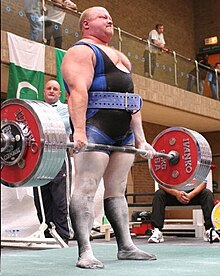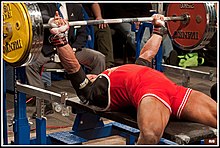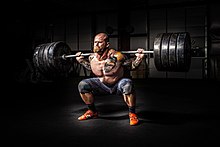Powerlifting

The powerlifting internationally also Powerlifting called, is a competitive sport in the heavy athletics or the strength game and is composed of the three disciplines squats , bench press and deadlift together (official order).
Powerlifting can best be compared to Olympic weightlifting (snatch and push). The aim is to cope with the greatest possible loads. Although good technique is very important and a great deal of attention is paid to it in training, only weight is important in competition.
Powerlifting in competition
The competitors are divided into age and weight classes. They are allowed three attempts in each discipline. An additional fourth attempt could be approved in exceptional cases, if the aim was to set a new record. The performance achieved in the fourth attempt was not included in the competition evaluation. In 2007, the fourth attempt was completely abolished in order to enable the competition to be carried out more quickly.
Age groups
There are the following age groups: youth (14-18 years), juniors (19-23 years), general class (24-39 years), Masters (from 40 years Masters I, from 50 years Masters II, from 60 years Masters III, from 70 years Masters IV).
In the Federal Association of German Powerlifters (BVDK), the age group of young people has also been divided into the B youth (14–15 years) and the A youth (16–18 years) since 2010. The B-youth is not allowed to use supporting equipment, so-called equipment (see below) during competitions. Only lifting belts as well as wrist bandages and knee warmers as protection against injuries to the spine and joints, which are still growing at this age, are allowed.
Weight classes
The IPF had the following weight classes until the end of 2010:
Women -48 kg, -52 kg, -56 kg, -60 kg, -67.5 kg, -75 kg, -82.5 kg, -90 kg, +90 kg
Men -56 kg, -60 kg, -67.5 kg, -75 kg, -82.5 kg, -90 kg, -100 kg, -110 kg, -125 kg, +125 kg
For the age groups of youth and juniors there are also the weight classes -44 kg (women) and -52 kg (men), which were abolished in 2007 for the other age groups due to the lack of people at competitions.
The following weight classes have been in effect since 2011:
Women up to 43 kg only youth and juniors, 47 kg, 52 kg, 57 kg, 63 kg, 72 kg, 84 kg, 84 kg +
Men up to 53 kg only youth and juniors, 59 kg, 66 kg, 74 kg, 83 kg, 93 kg, 105 kg, 120 kg, 120 kg +
In addition, new world record standards have been introduced for each weight class.
The execution of the individual exercises is subject to strict regulations. Each athlete has three attempts per discipline, in which the highest possible weight must be overcome. When a lifter prepares to try, the disc pins can help the lifter lift the dumbbell out of the stand. They can also help to put the dumbbell back in the stand after the attempt. They also secure the athlete. You are responsible for loading and unloading the dumbbell and clean the dumbbell bar or the competition platform when requested by the main referee. From one attempt to the next, the weight may only be increased or left unchanged, but not decreased. The best attempts in each discipline are added up and recorded as the total weight. The athlete with the highest total weight (also called total ) in a weight class wins the class. If two or more athletes manage the same total weight, the body weight determined during the weighing before the competition decides on the placement: The athlete with the lower body weight is placed in the ranking before the heavier athlete. If an overall winner is also chosen, the choice is made on the basis of the relative points evaluation (performance in relation to body weight according to Wilks).
For the evaluation of the exercises three judges (one main judge, two side judges) are arranged around the competition platform. The main referee is responsible for the commands ("Bend" / "Down", "Start" / "Press" / "Down", "Down"). Failure to observe these commands will result in an attempt being considered invalid.
Relative points according to Wilks
The Wilks formula - based on the Australian Robert Wilks - evaluates the athlete's performance depending on his body weight and gender, but without taking age into account. The winner is the one with the highest number of points. The score is equal to the product of weight and Wilks coefficient . The weight is the load that is moved in a competition, the Wilks coefficient results from the so-called Wilks table, which is a list of coefficients for different body weights (from 40.0 kg in increments of 100 grams). Men and women have different Wilks coefficients. The IPF publishes Wilks' coefficients for body weights from 40.0 kg to 150.9 kg for women and up to 205.9 kg for men. The BVDK has adopted these Wilks coefficients in its' Technical rules in powerlifting according to IPF '(valid from June 2011, in chapter '12 .5 The Wilks points'), where they are referred to as' point factors'. According to this: "The table is built up in steps of a tenth of a kilogram, interpolation (averaging) may have to be carried out. "From 2020, the Wilks points for team competitions will be replaced by the DOTS relative scoring .
National and international
The BVDK is the German powerlifting association that belongs to the DOSB , in Austria it is the Austrian Association for Powerlifting (ÖVK). There are also other smaller associations.
The umbrella organization for powerlifting is the International Powerlifting Federation (IPF).
In contrast to weightlifting , powerlifting is not an Olympic discipline, but the bench press is Paralympic (see also Paralympics ). The World Games , which also take place every 4 years, have established themselves as an Olympic alternative for a large number of sports that have no place at the Olympics , and their program also includes powerlifting, albeit with different weight classes. In addition, the ranking at the World Games is determined based on the relative points achieved.
There are of course also national, German / Austrian, European and world championships, in addition there are federal leagues in Germany and the Austria Cup in Austria.
Women have now asserted themselves in the male-dominated sport and take part in international comparisons themselves.
doping
Maximum strength performance can be influenced by the use of anabolic steroids . While the BVDK practices doping controls by NADA and DOSB , the World Powerlifting Congress rejects doping controls in the professional sports section of the association, but does so in amateur sports. Since there are no doping controls in the circus or wrestling (or in any other occupation), the professional sports association demands that these be waived. In 2014, the association was represented in 51 countries, including Germany, Austria and Switzerland.
Variants, equipment and resources
A distinction is made between two forms of powerlifting:
Powerlifting with supporting equipment (equipment)
The equipment consists of the following components (it is very difficult to determine a maximum increase in performance through the equipment, as this is individual for each athlete and depends on the manufacturer, correct size, adapted technology, etc.):
- Bowed suit
- Bench press shirt
- Knee braces
- Deadlift suit
- Swing rack
This variant is much more common in the US than outside. In addition to maximum strength, top performance depends on making good use of the supporting equipment, which not all athletes can do equally well. The comparability of the performances is made more difficult by the fact that many different associations - especially in the USA - have their own deviating equipment rules; these can even contain regulations about who manufactured the equipment ("manufacturer link").
Powerlifting without supporting equipment - raw powerlifting
With this variant, only a belt, wrist and knee supports are allowed as equipment.
In principle, all variants and their regulations with regard to permitted and forbidden techniques and equipment and auxiliary materials (e.g. pulling aids) are dealt with in rulebooks depending on the association and are mandatory for association competitions, otherwise the organizer of a competition can specify rules in its announcement.
World records
Women with equipment according to IPF standards.
| discipline | Athlete | Weight | year |
|---|---|---|---|
| Squat | Gemaletdinova Olga (Russia) | 310.0 kg | 2011 |
| Bench press (single lift) | Lonn Sandra (Sweden) | 235.0 kg | 2015 |
| Bench press | Hugdal Hildeborg (Norway) | 227.0 kg | 2014 |
| Deadlift | Gemaletdinova Olga (Russia) | 270.5 kg | 2013 |
Women without equipment according to IPF standards.
| discipline | Athlete | Weight | year |
|---|---|---|---|
| Squat | Lough Bonica (USA) | 272.5 kg | 2016 |
| Bench press (single lift) | Lough Bonica (USA) | 151.0 kg | 2016 |
| Bench press | Lough Bonica (USA) | 151.0 kg | 2016 |
| Deadlift | Hewitt LeeAnn (USA) | 238.0 kg | 2016 |
Men with equipment
| discipline | athlete | Weight | year |
|---|---|---|---|
| Squats (Squat) | Jonas Rantanen (FIN) | 575.00 kg | 2011 |
| Bench press (Bench Press) | Ryan Kennelly (USA) | 487.61 kg (1075 lbs) | 2008 |
| Cross lifting (lift Dead) | Andy Bolton (UK) | 457.5 kg (1008.6 lbs) | 2009 |
| Kreuzheben (Dead elevator) (with power strap) | Hafthor Björnsson (ISL) | 501 kg (1104.52 lbs) | 2020 |
Men without equipment (also referred to as raw (dt. Raw ))
| discipline | athlete | Weight | year |
|---|---|---|---|
| Squats (Squat) | Ray Williams (USA) | 477.5 kg (1053 lbs) | 2017 |
| Bench press (Bench Press) | Julius Maddox (USA) | 337 kg (743 lbs) | 2019 |
| Cross lifting (lift Dead) | Benedikt Magnússon (IS) | 460 kg (1015 lbs) | 2009 |
| Kreuzheben (Dead elevator) (with power strap) | Eddie Hall (UK) | 465 kg (1025 lbs) | 2016 |
Web links
- Federal Association of German Powerlifters eV
- Swiss powerlifting associations (SPCO & Swiss-IPF)
- kraftdreikampf.at
- powerlifting-ipf.com
- europowerlifting.org
See also
Individual evidence
- ↑ Source IPF ( Memento of the original from June 26, 2011 in the Internet Archive ) Info: The archive link was inserted automatically and has not yet been checked. Please check the original and archive link according to the instructions and then remove this notice. (PDF; 178 kB)
- ↑ Archived copy ( memento of the original from October 10, 2011 in the Internet Archive ) Info: The archive link was inserted automatically and has not yet been checked. Please check the original and archive link according to the instructions and then remove this notice. (PDF; 49 kB)
- ↑ Archived copy ( memento of the original dated August 29, 2011 in the Internet Archive ) Info: The archive link was inserted automatically and has not yet been checked. Please check the original and archive link according to the instructions and then remove this notice. ; PDF; 7.3 MB)
- ↑ [ https://bvdk.de/dots-punkte-f%C3%BCr-mannschaftswettk%C3%A4ampf-ab-2020 ], publication of the BVDK on the association's website.
- ↑ Juan Manuel Garcia Manso: La Fueza. Findamentatcion, Valoracion y Entrenamiento. Gymnos, Madrid 1999, p. 139. cf. Arnd Krüger : Spanish doping documentation at its best. NZZ February 9, 2000. Archived copy ( memento of the original from August 8, 2014 in the Internet Archive ) Info: The archive link was inserted automatically and has not yet been checked. Please check the original and archive link according to the instructions and then remove this notice.
- ↑ http://www.worldpowerliftingcongress.com/
- ↑ http://www.upc-germany.com/
- ↑ http://www.powerlifting.ch/home/
- ^ Records - International Powerlifting Federation IPF. In: www.powerlifting-ipf.com. Retrieved November 29, 2016 .
- ^ Records - International Powerlifting Federation IPF. In: www.powerlifting-ipf.com. Retrieved November 29, 2016 .
- ^ Pride Strength Wars Results . Pride powerlifting. November 8, 2008. Archived from the original on December 20, 2008. Info: The archive link was automatically inserted and not yet checked. Please check the original and archive link according to the instructions and then remove this notice. Retrieved November 11, 2008.
- ↑ Soong, Michael: "Men's All-Time World Records" ( Memento of the original from February 25, 2012 in the Internet Archive ) Info: The archive link was automatically inserted and not yet checked. Please check the original and archive link according to the instructions and then remove this notice. (PDF; 129 kB), "Powerlifting Watch", accessed December 30, 2011
- ↑ Hafthor Björnsson: “GoT” star breaks world record in deadlift. May 4, 2020, accessed on June 9, 2020 (German).

